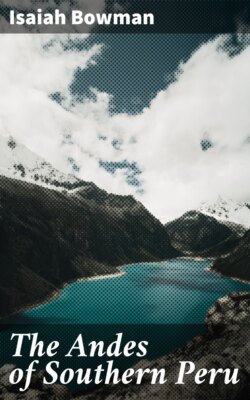The Andes of Southern Peru

Реклама. ООО «ЛитРес», ИНН: 7719571260.
Оглавление
Isaiah Bowman. The Andes of Southern Peru
The Andes of Southern Peru
Table of Contents
PREFACE
SPECIAL ACKNOWLEDGMENTS FOR ILLUSTRATIONS
PART I. HUMAN GEOGRAPHY
CHAPTER I. THE REGIONS OF PERU
The Forest Dweller
The Eastern Valley Planter
The Highland Shepherd
The Coastal Planter
CHAPTER II. THE RAPIDS AND CANYONS OF THE URUBAMBA
CHAPTER III. THE RUBBER FORESTS
CHAPTER IV. THE FOREST INDIANS
CHAPTER V. THE COUNTRY OF THE SHEPHERDS
CHAPTER VI. THE BORDER VALLEYS OF THE EASTERN ANDES
CHAPTER VII. THE GEOGRAPHIC BASIS OF REVOLUTIONS AND OF HUMAN CHARACTER IN THE PERUVIAN ANDES
CHAPTER VIII. THE COASTAL DESERT
CHAPTER IX. CLIMATOLOGY OF THE PERUVIAN ANDES
CLIMATIC BELTS
THE CLIMATE OF THE COAST
EASTERN BORDER CLIMATES
INTER-ANDEAN VALLEY CLIMATES
CHAPTER X. METEOROLOGICAL RECORDS FROM THE PERUVIAN ANDES
Introduction
Machu Picchu[27]
CLOUDINESS
Santa Lucia[29]
TEMPERATURE
RAINFALL
WIND
CLOUD
UNUSUAL WEATHER PHENOMENA, SANTA LUCIA, 1913–14
Morococha
Temperature
RAINFALL
Cochabamba
PART II. PHYSIOGRAPHY OF THE PERUVIAN ANDES
CHAPTER XI. THE PERUVIAN LANDSCAPE
CHAPTER XII. THE WESTERN ANDES: THE MARITIME CORDILLERA OR CORDILLERA OCCIDENTAL
CHAPTER XIII. THE EASTERN ANDES: THE CORDILLERA VILCAPAMPA
GLACIERS AND GLACIAL FORMS
THE VILCAPAMPA BATHOLITH AND ITS TOPOGRAPHIC EFFECTS
CHAPTER XIV. THE COASTAL TERRACES
CHAPTER XV. PHYSIOGRAPHIC AND GEOLOGIC DEVELOPMENT
GENERAL FEATURES
SCHISTS AND SILURIAN SLATES[50]
CARBONIFEROUS
CRETACEOUS
TERTIARY
The Coastal Tertiary
PLEISTOCENE
CHAPTER XVI. GLACIAL FEATURES
THE SNOWLINE
NIVATION
BERGSCHRUNDS AND CIRQUES
ASYMMETRICAL CREST LINES AND ABNORMAL VALLEY PROFILES IN THE CENTRAL ANDES
APPENDIX A. SURVEY METHODS EMPLOYED IN THE CONSTRUCTION OF THE SEVEN ACCOMPANYING TOPOGRAPHIC SHEETS
Cross-Section Map from Abancay to Camaná at the Pacific Ocean
Conclusions
APPENDIX B. Fossil Determinations
I. Silurian
II. Lower Devonian
III. Upper Carboniferous
IV. Comanchian or Lower Cretaceous
APPENDIX C. KEY TO PLACE NAMES
INDEX
Отрывок из книги
Isaiah Bowman
Geographical Reconnaissance along the Seventy-Third Meridian
.....
Fig. 8—Sketch map showing the route of the Yale-Peruvian Expedition of 1911 down the Urubamba Valley, together with the area of the main map and the changes in the delineation of the bend of the Urubamba resulting from the surveys of the Expedition. Based on the “Mapa que comprende las ultimas exploraciones y estudios verificados desde 1900 hasta 1906,” 1:1,000,000, Bol. Soc. Geogr. Lima, Vol. 25, No. 3, 1909. For details of the trail from Rosalina to Pongo de Mainique see “Plano de las Secciones y Afluentes del Rio Urubamba: 1902–1904,” scale 1:150,000 by Luis M. Robledo in Bol. Soc. Geogr. Lima, Vol. 25, No. 4, 1909. Only the lower slopes of the long mountain spurs can be seen from the river; hence only in a few places could observations be made on the topography of distant ranges. Paced distances of a half mile at irregular intervals were used for the estimation of longer distances. Directions were taken by compass corrected for magnetic deviation as determined on the seventy-third meridian (See Appendix A). The position of Rosalina on Robledo’s map was taken as a base.
We could gather almost no information as to the nature of the river except from the report of Major Kerbey, an American, who, in 1897, descended the last twenty miles of the one hundred we proposed to navigate. He pronounced the journey more hazardous than Major Powell’s famous descent of the Grand Canyon in 1867—an obvious exaggeration. He lost his canoe in a treacherous rapid, was deserted by his Indian guides, and only after a painful march through an all but impassable jungle was he finally able to escape on an abandoned raft. Less than a dozen have ventured down since Major Kerbey’s day. A Peruvian mining engineer descended the river a few years ago, and four Italian traders a year later floated down in rafts and canoes, losing almost all of their cargo. For nearly two months they were marooned upon a sand-bar waiting for the river to subside. At last they succeeded in reaching Mulanquiato, an Indian settlement and plantation owned by Pereira, near the entrance to the last canyon. Their attempted passage of the worst stretch of rapids resulted in the loss of all their rubber cargo, the work of a year. Among the half dozen others who have made the journey—Indians and slave traders from down-river rubber posts—there is no record of a single descent without the loss of at least one canoe.
.....